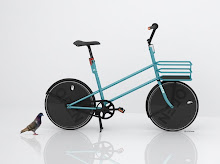My most popular blog entry is about what I call "lux-narcissism", i.e. over-lighting a bike and its rider to the detriment of others legally-illuminated, and pedestrians. I have also written about this invention from Sweden and helmetism in general many times before.
The Hövding is the ultimate example of bicycle safety narcissism. Aside from the obnoxious marketing hyperbole it costs EUR 400 in the EU and 600 in the USA. IF you really think a helmet can help, then buy five 60 dollar helmets for friends and give 300 dollars to your local bicycle coalition or another org. fighting desperately to keep streets save and collisions from happening in the first place.
Very much related, in 2005 helmets became mandatory in Sweden for people up to their 15th birthday and this has not helped improve cycling modal share. So - at least in part - this creation is opportunist.
Please notice that I am not mentioning efficacy, durability, its single use function, comfort or any other technical or aesthetic issues. I also hope that my criticism would be the same for a project led by two men.
The problem is that it is simply far too expensive for most people. Their whole business plan is totally wrong -- they got money from the Swedish or regional government but also from private sources. Regarding the latter, they obviously completely screwed up and should have required a much longer period that investors were willing to wait to get paid back.
It is truly a pity because maybe this works... maybe not. People joke about the "Chinese" ripping off the design, so we'll see if the price on devices exactly like this or better comes down by a factor of five.
Again, I am against helmet requirements for any age group, helmet promotion by governments and similar from non-profits (e.g. urban cycling organizations) which do not show the real deal with helmet efficacy. Most helmet companies also use a lot of hyperbole or even insults e.g. "I Love my Brain".
I am for infrastructure, training and enforcement that ensures that people on bikes and everyone else dwelling in, visiting or just using the street are as safe, social and have as much fun as they want.



















